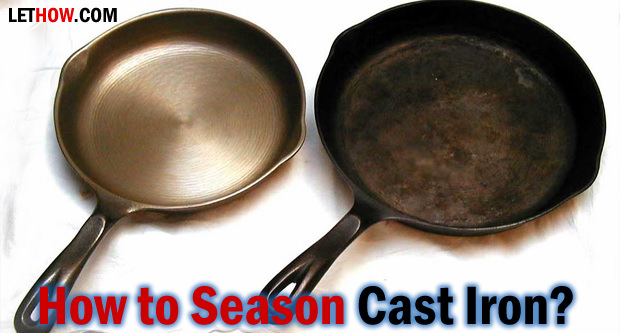In this article, we will discuss the ways to season cast iron. Cast iron is considered one of the best surfaces to cook on. However, taking care of it is a complete different story. Cleaning a cast iron skillet is not as simple as just washing other pans in soapy water. Everyone has their own way about how to clean a cast iron. It may seem menacing at first, but once you learn the basics, you’ll be making the best homemade pizza, steaks, fried chicken, and many other dishes. But, before you start cooking your favorite food on a cast iron utensil, let us know about some of most important things you need to know about seasoning, cleaning, and maintaining your cast iron cookware.
What Does “Season Cast Iron” Mean?
The solid, black layer which gives cast iron its shiny finish is known as the seasoning, or patina. The patina is made by the oxidization of fats, that causes them to bond with each other. This make a dense, solid, dry layer. The metal is super porous, so the fats get inside the pores and seal the surface. The seasoning of cast iron prevents it from rusting and making it non-stick. You surely would never want to try using cast iron without seasoning it. This is because the porous surface makes it very sticky and difficult to use it next time. Even if a pan is pre-seasoned, you can a better, longer lasting patina if you season it again by yourself.
Steps to Season Cast Iron:
1.) Wash to Season Cast Iron
Wash the cast iron cookware using a lukewarm, soapy water and a hard nylon brush. If the cookware is rusty, scrub it with a steel wool. Rinse and dry it properly.
2.) Oiling to Season Cast Iron
After washing your cast iron utensil, apply a thin layer of vegetable oil. Coat the entire surface of the pan with this oil using a paper towel. Oil it from both inside and outside. Keep the utensil aside. You can use coconut oil to season a cast iron pan.
3.) Heating to Season Cast Iron
After oiling the patina properly, keep it aside. Now, place an aluminum foil on the bottom row of your oven to prevent it from oil drips. Now, place the oiled pan in the oven. Heat oven to about 350°F.
4.) Bake The Pan For an Hour to Season Cast Iron
When placing the cookware, place it upside down on the top rack of the oven. Placing it in this manner will let the oil drip down and coat the whole pan. Let the pan in the oven to “bake” for one hour.
5.) Let it Cool
After baking the cast iron for an hour, switch off the oven. Allow the skillet to cool in the oven, or with the help of mitts, remove it from the oven and place it on a wire rack to cool for an hour at least. Keep your newly re-seasoned cast iron skillet uncovered in a dry place.
6.) Remove Residual Food Quickly After Cooking
An ideal way to get rid of residual food which has just been cooked is quite simple. Just follow the below listed steps:
- Add a little amount of oil and salt to a still-hot pan.
- Scrub the surface with the help of a paper towel.
- Finally, tip out everything and keep the pan in storage.
Tips to Remember:
- If you wash the cast iron with too much force (for example, with a scouring pad), you will be scrubbing off the seasoning. Therefore, wash it more gently or repeat the oven-seasoning technique regularly.
- After cleaning it after each use, it is considered best to keep the cast iron utensil in the oven on 350ºF/180ºC for about 10 minutes or more. This will help make all water vaporized from the surface of the cast iron.
- It is very necessary to always use a flat stainless steel spatula while cooking with cast iron. The steel spatula will help keep the bottom of the pan from becoming “bumpy”. It will also help maintain a glass like surface.
- If the food burns, simply heat a little water in the pan, and scratch with a flat metal spatula. It may be an indication of re-seasoning your cast iron.
- Some companies offer pre-seasoned cast iron pans. You can do an online search for some suitable brands.
- If your pan gets a thick crust, it means you’re not washing it strongly enough.
- Avoid washing cast iron frequently.


